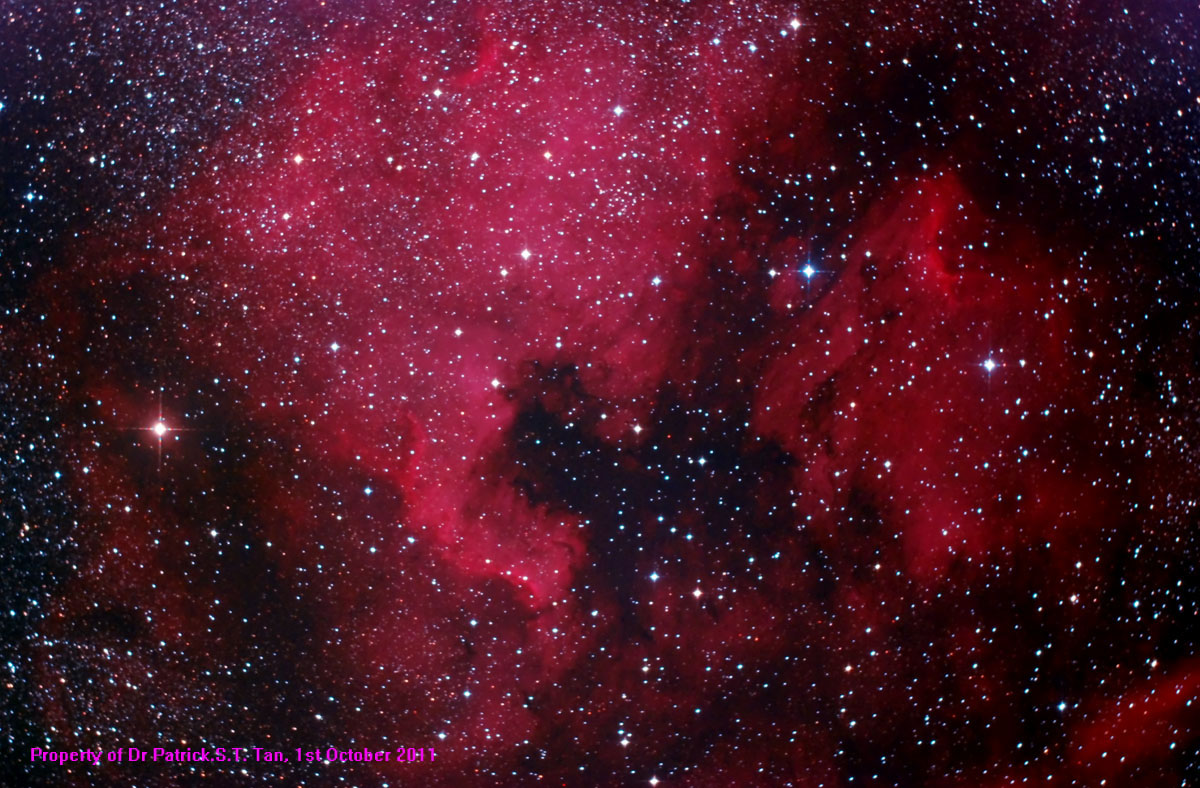
NGC 7000: North America Nebula
IC 5067: Pelican Nebula
Date: 01/10/11 Time: 2015hrs Location: Sunningwell Temperature: 19.9ºC Relative Humidity: 57%
Camera: Nikon D80 Scope: William Optics Z66 Apo Doublet at prime focus Field-flattener: William Optics VIII 0.8x focal reducer Mount: piggy-backed on Meade LX90 in equatorial mode Filter: Astronomik CLS (LPF broadband filter) Exposures: 8 x 10 minutes ISO: 1600 F ratio: 5.9 Guidance: Autoguided
In August 2007, after I first bought the Nikon D80, I took a photo of this amazing late summer nebula using a terrestrial Nikkor 70-300mm zoom lens at 300mm. I knew the end result would have been much better using an apochromatic lens or refractor and after 3 years, I finally got round to aiming the telescope at Deneb again. You can compare this with the previous experiment by clicking on this link. Both the Pelican nebula and North America nebula (named after the shapes they most resemble) are part of the same emission-nebula consisting of an extensive H II region in the constellation Cygnus which is directly overhead at about 10pm at this time of year. The hydrogen molecular cloud is being made to fluoresce by energetic stars nearby. Reference sources seem to disagree over its distance from us - anything between 1800 to 2200 light years. The source of energy giving rise to the hydrogen-alpha emissions from this molecular cloud is also unclear. The red star on the left (Xi Cygni) and the blue star on the right (57 Cygni) are both in front of the nebula and only about 500 light years from us. Deneb - the brightest star in Cygnus is just outside the picture to the right. A word about the Pelican nebula - it's like a Rorschach ink-blot test which Psychologists use to characterise personalities of their patients. I used to think the Pelican was rather abstract... until I saw the Pelican's bill. Now the Pelican is as obvious to me as any other bird in a tree! This is only because of the power of suggestion and the willingness of the human mind to see patterns in everything.
I will remember the evening of this photograph as a Saturday at the peak of an unseasonal early autumn heatwave where the daytime temperature rose as high as 29degC (84degF) and the evening remained a balmy 20degC (68degF). The moon was early in the first quarter and made a lovely moonset photograph as it hovered over my neighbour's Cypress tree hedge. Seeing was good as the air was still but transparency was poor as it always is after a hot humid day. 10 exposures of 10 minutes were achieved but 2 were ruined, one with an aircraft flying through the target field, and the other was interrupted during dark subtraction. This left an 80 minute cumulative exposure which is ample for such a relatively bright nebula. The usual processing: background light pollution subtraction, white and black point setting in the levels command of Photoshop, midtone enhancement with the curves command and one pass of Noise-Ninja at default settings. Below is the photograph I took of the setting moon:
HOME PICTURES: Solar system PICTURES: Wide field